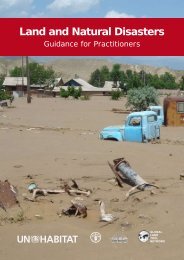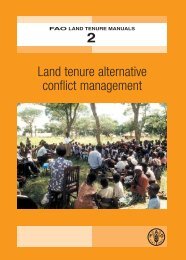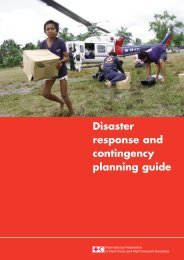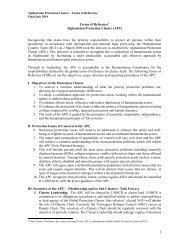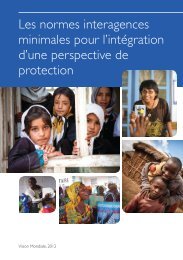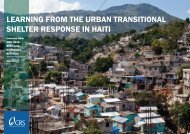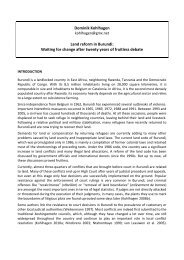Inter-Agency Real Time Evaluation of the Response to Cyclone Nargis
Inter-Agency Real Time Evaluation of the Response to Cyclone Nargis
Inter-Agency Real Time Evaluation of the Response to Cyclone Nargis
Create successful ePaper yourself
Turn your PDF publications into a flip-book with our unique Google optimized e-Paper software.
and whe<strong>the</strong>r it is something that can be built upon and sustained once <strong>the</strong> emergency phaseconcludes?What efforts are being undertaken <strong>to</strong> address accountability <strong>to</strong> <strong>the</strong> beneficiary community?PredictabilityHow <strong>the</strong> international community has been at strategic planning in this humanitarian context – bothwithin and external <strong>to</strong> – <strong>the</strong> cluster system, for initial response and early recovery programming willbe a focus <strong>of</strong> <strong>the</strong> evaluation, as well as <strong>the</strong> efforts undertaken <strong>to</strong> help build national capacities <strong>to</strong>harness response <strong>to</strong> <strong>the</strong> humanitarian crisis. Fur<strong>the</strong>r, a view will be afforded as <strong>to</strong> how and whatextent local organizations been involved in <strong>the</strong> response, and whe<strong>the</strong>r it likely <strong>to</strong> reflect astreng<strong>the</strong>ning over time <strong>of</strong> civil society. Emphasis will be placed on what mechanisms are beingemployed, or created, <strong>to</strong> ensure sustainability/connectedness <strong>of</strong> operations uponwithdrawal/departure <strong>of</strong> international staff. Fur<strong>the</strong>r, an assessment <strong>of</strong> how effectively <strong>the</strong> earlyrecovery planning and implementation has been integrated in<strong>to</strong> <strong>the</strong> humanitarian effort will be putforth.Specific questions <strong>to</strong> be addressed may include:How effective was <strong>the</strong> cluster coordination mechanism in facilitating mobilization andsetting <strong>the</strong> direction <strong>of</strong> <strong>the</strong> response? For those clusters that have recently, or are in <strong>the</strong>process <strong>of</strong> deactivation or hand over, is <strong>the</strong>re a smooth transition?How has <strong>the</strong> coordination structure helped <strong>to</strong> build national capacities <strong>to</strong> harness response <strong>to</strong><strong>the</strong> humanitarian crisis, both at <strong>the</strong> Yangon and field levels?What information is being collected by <strong>the</strong> clusters and how is it being collected (i.e. what<strong>to</strong>ols are being employed <strong>to</strong> collect and manage information, and by whom)? How effectivewhere information flows within and among <strong>the</strong> various local and regional ac<strong>to</strong>rs, including<strong>the</strong> private sec<strong>to</strong>r?How has <strong>the</strong> international community been at strategic planning in this humanitarian context– both within and external <strong>to</strong> – <strong>the</strong> cluster system?Are <strong>the</strong>re examples <strong>of</strong> unusual collaboration and/or creative partnerships at <strong>the</strong> local,national and international level? How are ASEAN and <strong>the</strong> TCG facilitating <strong>the</strong>humanitarian/early recovery endeavor?How have local organizations been involved in <strong>the</strong> response? Is it likely <strong>to</strong> reflect astreng<strong>the</strong>ning over time <strong>of</strong> civil society? What mechanisms are in place, or are in <strong>the</strong>process <strong>of</strong> being put in<strong>to</strong> place, <strong>to</strong> ensure sustainability/connectedness <strong>of</strong> operations uponwithdrawal/departure <strong>of</strong> international staff?In <strong>the</strong> transition <strong>to</strong> early recovery, how have early recovery plans been integrated in<strong>to</strong> <strong>the</strong>humanitarian response?What has <strong>the</strong> been <strong>the</strong> affect <strong>of</strong> <strong>the</strong> restrictions on recruitment <strong>of</strong> and deployment <strong>of</strong>international staff on operations, and what have been/are <strong>the</strong> strategic implications <strong>of</strong> <strong>the</strong>rapid scale up?Coordination & PartnershipThe evaluation will look at <strong>the</strong> coordination mechanisms employed during this response at <strong>the</strong> field,country, regional and global level, highlighting <strong>the</strong> major accomplishments and shortcomings. Inaddition <strong>to</strong> <strong>the</strong> overall operational effectiveness <strong>of</strong> <strong>the</strong> cluster approach (including <strong>the</strong> role <strong>of</strong> <strong>the</strong>Global Clusters) in facilitating and supporting <strong>the</strong> joint humanitarian response at country level, andon allowing appropriate delivery <strong>of</strong> humanitarian assistance. Emphasis will also be placed on44



